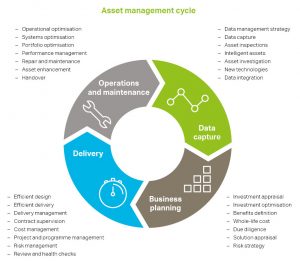Better managing risk
Water specialist Martin Williamson discusses future opportunities for flood risk asset management to become more integrated, innovative and cost-effective.
The UK’s flood defences save lives, homes and damage to local infrastructure every year. Yet managing flood risk assets across entire or multiple boroughs or catchments can be complex and challenging; especially as local authorities face more flood risk management duties and have more assets to take care of, often with less money to spend.
There are, however, great opportunities for local authorities and the EA to better manage their assets by engaging the community, learning from the wider water industry and by using innovative technologies to find out if assets are degrading or failing, which ones need repairing or replacing, and when it’s the optimum time to invest in them.
A cohesive, strong partnership is needed for a local funding approach to work.
Challenge or opportunity?
Perhaps one of the biggest challenges — or opportunities — in flood risk asset management today is the government’s push for communities and the private sector to contribute to funding for flood risk management schemes, encouraging local asset ownership and management. By topping up government funding, there’s also a better chance of individual schemes going ahead.
For a local funding approach to work, a cohesive and strong partnership is needed between the EA, local authorities and communities. However, encouraging communities and private investors to contribute towards the maintenance of defences in remote locations or those that sit dormant for long periods can be tricky.
Due to the infrequent use of flood risk management assets, they’re often taken for granted and don’t attract the investment they deserve in today’s economic climate. But flood risk assets are only as strong as their weakest link; if a river is bounded by 10 properties and only nine of the landowners maintain their defences, there’s a chance all 10 could be flooded due to failure of the under-maintained defence.
A cohesive approach
For the government’s new partnership plan to succeed, a holistic approach to managing flood risk assets is crucial.
We’ve been working on several projects with local authorities to help communities adapt, manage and respond to risks of tidal flooding. Through exhibitions, workshops and face-to-face meetings with key individuals and stakeholders, we’ve helped educate residents about the need to work together to protect local areas from the risks. On one of the projects, we helped Eastleigh Borough Council negotiate and secure a third of the money needed to fund coastal protection works, demonstrating the real difference that partnerships and community galvanisation can make.
Learning from others
Water companies rely on vast networks of pipes to supply water and take away wastewater from thousands of people across large areas, so managing their assets is vital for business. For this reason, water companies have become leaders in monitoring, maintaining and repairing their assets over large areas and entire catchments — something flood risk asset management teams can learn from.
 Using AECOM’s group of asset investment tools, aiSuite, we’re helping water companies gather and analyse data generated from across their entire buried networks to help them invest in the right places. This is maximising the impact and minimising the cost of their maintenance programmes, which not only improves the asset performance, but the methodology begins to proactively address serviceability incidents, such as sewer flooding, before they’ve
Using AECOM’s group of asset investment tools, aiSuite, we’re helping water companies gather and analyse data generated from across their entire buried networks to help them invest in the right places. This is maximising the impact and minimising the cost of their maintenance programmes, which not only improves the asset performance, but the methodology begins to proactively address serviceability incidents, such as sewer flooding, before they’ve
even occurred.
Flood risk assets are only as strong as their weakest link.
Smart technology
Currently, flood risk assets are checked relatively infrequently and in a simplistic way, for example, by taking photographs of a flood wall to check for cracks. By using innovative technologies, such as 3D lasers and scanners, which can be attached to drones or waterborne craft, assets can be monitored quickly and more frequently with more precision and over much larger areas. This process is also a non-invasive and a cost-effective way of collecting large amounts of data that can be easily integrated within modelling software.
 Scanners and lasers work by measuring the external ‘points’ of an asset to generate detailed cloud point data, which can be downloaded to produce 3D, simulated images of the structure. Clever software is then used to overlay the images to determine things like the rate of movement and to highlight new areas of damage or deterioration. The data can also be easily integrated into flood modelling software to predict the impact of asset performance on flood extents.
Scanners and lasers work by measuring the external ‘points’ of an asset to generate detailed cloud point data, which can be downloaded to produce 3D, simulated images of the structure. Clever software is then used to overlay the images to determine things like the rate of movement and to highlight new areas of damage or deterioration. The data can also be easily integrated into flood modelling software to predict the impact of asset performance on flood extents.
Drawing on the experience of our highways and rail teams who use lasers to create accurate, detailed pictures of roads and railways to pin point where damage has or may occur in the future, we can create a snapshot of entire flood risk assets to ensure local authorities invest in the right areas before flooding happens.
Water companies are leaders in monitoring, maintaining, and repairing their assets over large areas and entire catchments.
Benchmarking costs
Just as water companies have made the leap to thinking in terms of total expenditure of their entire networks in the current asset management period, AMP6, benchmarking the costs of managing flood risk assets to determine how much investment is needed to manage them over
their entire lifetime is key to the industry moving to the next level. But because flood risk assets usually have multiple owners, and there’s no integrated data available, capturing the likely costs of managing an asset over its lifetime is rarely possible.
If we can generate more accurate, integrated data through innovative and new ways of working, such as with cloud point data to determine the benefit versus the cost of maintaining an asset over its lifetime, then local authorities and the EA can save large amounts of money to better manage risk, and incentivise more private and community investment.

Catchment scale contracts
With the right data in place, the flood risk management industry can begin to invest in long-term asset management contracts, such as Thames Estuary 2100 (TE2100) in the UK. The multi-million pound strategy considers the whole life cycle of assets along the Thames and brings about a more holistic, catchment management approach to help drive down costs for the EA, while reducing long-term flood risk to entire catchments.
The application of these new technologies and capturing better cost data will allow flood risk management to move away from just capital replacement schemes into holistic asset management programmes, reducing overall cost while better managing the risk to communities.
aiSuite: Reducing the risk
With ageing water infrastructure across the UK, long-term, cost-effective asset management is a top priority for water companies.
To help them pinpoint which of their sewer pipes are performing poorly and to reduce the number of sewers collapsing, we’re using our in-house data management tools, aiSuite, to optimise investment across entire public sewer networks.
Using the technology, we’re generating the right data needed to determine the condition and location of the pipes, which our teams are able to analyse alongside data of actual pipe failures to determine rates of deterioration.
By delivering our approach across entire water company regions, we’re helping our clients estimate when they will need to renew or replace their assets, which is helping to improve efficiency, avoid timely and costly sewer collapses, avoid community disruption and ultimately optimise the whole life management costs of their assets.






